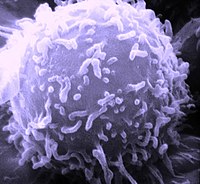
Photo from wikipedia
Simple Summary NSCLC accounts for approximately 84% of lung malignancies and the clinical application of ICIs provides a novel and promising strategy. However, approximately 80% of NSCLC patients do not… Click to show full abstract
Simple Summary NSCLC accounts for approximately 84% of lung malignancies and the clinical application of ICIs provides a novel and promising strategy. However, approximately 80% of NSCLC patients do not benefit from ICIs due to drug resistance complicated by disciplines and diverse mechanisms. Through this review, we provide a whole map of current understanding of primary and acquired resistance mechanisms in NSCLC. In the first part, resistance mechanisms of 6 FDA-approved ICIs-related primary resistance are collected and arranged into 7 steps of the well-known cancer-immunity cycle. Acquired resistance induced by ICIs are summarized in the second part. In the third part, we discuss the future direction, including the deeper understanding of tumor microenvironment and the combinational treatment. Through this review, clinicians can get clear and direct clues to find the underlying mechanisms in patients and translational researchers can acquire several directions to overcome resistance and apply new combinational treatment. Abstract Immune checkpoint inhibitors have emerged as the treatment landscape of advanced non-small cell lung cancer (NSCLC) in recent years. However, approximately 80% of NSCLC patients do not benefit from ICIs due to primary resistance (no initial response) or acquired resistance (tumor relapse after an initial response). In this review, we highlight the mechanisms of primary and secondary resistance. Furthermore, we provide a future direction of the potential predictive biomarkers and the tumor microenvironmental landscape and suggest treatment strategies to overcome these mechanisms.
Journal Title: Cancers
Year Published: 2022
Link to full text (if available)
Share on Social Media: Sign Up to like & get
recommendations!